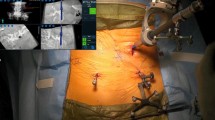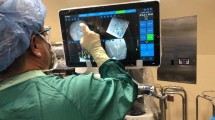Abstract
Background
Robotic assistance for the placement of pedicle screws has been established as a safe technique. Nonetheless rare instances of screw misplacement have been reported.The aim of the present retrospective study is to assess whether experience and time affect the accuracy of screws placed with the help of the SpineAssist™ robot system.
Methods
Postoperative computed tomography (CT) scans of 258 patients requiring thoracolumbar pedicle screw instrumentation from 2008 to 2013 were reviewed. Overall, 13 surgeons performed the surgeries. A pedicle breach of >3 mm was graded as a misplacement. Surgeons were dichotomised into an early and experienced period in increments of five surgeries.
Results
In 258 surgeries, 1,265 pedicle screws were placed with the aid of the robot system. Overall, 1,217 screws (96.2 %) were graded as acceptable. When displayed by surgeon, the development of percent misplacement rates peaked between 5 and 25 surgeries in 12 of 13 surgeons. The overall misplacement rate in the first five surgeries was 2.4 % (6/245). The misplacement rate rose to 6.3 % between 11 and 15 surgeries (10/158; p = 0.20), and reached a significant peak between 16 and 20 surgeries with a rate of 7.1 % (8/112; p = 0.03). Afterwards, misplacement rates declined.
Conclusions
A major peak in screw inaccuracies occurred between cases 10 and 20, and a second, smaller one at about 40 surgeries. One potential explanation could be a transition from decreased supervision (unskilled but aware) to increased confidence of a surgeon (unskilled but unaware) who adopts this new technique prior to mastering it (skilled). We therefore advocate ensuring competent supervision for new surgeons at least during the first 25 procedures of robotic spine surgery to optimise the accuracy of robot-assisted pedicle screws.


Similar content being viewed by others
References
Bai YS, Zhang Y, Chen ZQ, Wang CF, Zhao YC, Shi ZC, Li M, Liu KP (2010) Learning curve of computer-assisted navigation system in spine surgery. Chin Med J (Engl) 123:2989–2994
Devito DP, Kaplan L, Dietl R, Pfeiffer M, Horne D, Silberstein B, Hardenbrook M, Kiriyanthan G, Barzilay Y, Bruskin A, Sackerer D, Alexandrovsky V, Stuer C, Burger R, Maeurer J, Donald GD, Schoenmayr R, Friedlander A, Knoller N, Schmieder K, Pechlivanis I, Kim IS, Meyer B, Shoham M (2010) Clinical acceptance and accuracy assessment of spinal implants guided with SpineAssist surgical robot: retrospective study. Spine (Phila Pa 1976) 35:2109–2115
Gaines RW Jr (2000) The use of pedicle-screw internal fixation for the operative treatment of spinal disorders. J Bone Joint Surg Am 82-A:1458–1476
Gautschi OP, Schatlo B, Schaller K, Tessitore E (2011) Clinically relevant complications related to pedicle screw placement in thoracolumbar surgery and their management: a literature review of 35,630 pedicle screws. Neurosurg Focus 31, E8
Gertzbein SD, Robbins SE (1990) Accuracy of pedicular screw placement in vivo. Spine (Phila Pa 1976) 15:11–14
Herrell SD, Smith JA Jr (2005) Robotic-assisted laparoscopic prostatectomy: what is the learning curve? Urology 66:105–107
Holly LT, Foley KT (2003) Intraoperative spinal navigation. Spine (Phila Pa 1976) 28:S54–S61
Hu X, Lieberman IH (2014) What is the learning curve for robotic-assisted pedicle screw placement in spine surgery? Clin Orthop Relat Res 472:1839–1844
Kantelhardt SR, Martinez R, Baerwinkel S, Burger R, Giese A, Rohde V (2011) Perioperative course and accuracy of screw positioning in conventional, open robotic-guided and percutaneous robotic-guided, pedicle screw placement. Eur Spine J 20:860–868
Kim HJ, Lee SH, Chang BS, Lee CK, Lim TO, Hoo LP, Yi JM, Yeom JS (2015) Monitoring the quality of robot-assisted pedicle screw fixation in the lumbar spine by using a cumulative summation test. Spine (Phila Pa 1976) 40:87–94
Kosmopoulos V, Schizas C (2007) Pedicle screw placement accuracy: a meta-analysis. Spine (Phila Pa 1976) 32:E111–E120
Kruger J, Dunning D (1999) Unskilled and unaware of it: how difficulties in recognizing one’s own incompetence lead to inflated self-assessments. J Pers Soc Psychol 77:1121–1134
Lenihan JP Jr, Kovanda C, Seshadri-Kreaden U (2008) What is the learning curve for robotic assisted gynecologic surgery? J Minim Invasive Gynecol 15:589–594
Lieberman IH, Togawa D, Kayanja MM, Reinhardt MK, Friedlander A, Knoller N, Benzel EC (2006) Bone-mounted miniature robotic guidance for pedicle screw and translaminar facet screw placement: Part I—Technical development and a test case result. Neurosurgery 59:641–650, discussion 641-650
Pechlivanis I, Kiriyanthan G, Engelhardt M, Scholz M, Lucke S, Harders A, Schmieder K (2009) Percutaneous placement of pedicle screws in the lumbar spine using a bone mounted miniature robotic system: first experiences and accuracy of screw placement. Spine (Phila Pa 1976) 34:392–398
Ringel F, Stuer C, Reinke A, Preuss A, Behr M, Auer F, Stoffel M, Meyer B (2012) Accuracy of robot-assisted placement of lumbar and sacral pedicle screws: a prospective randomized comparison to conventional freehand screw implantation. Spine 37:E496–E501
Schatlo B, Molliqaj G, Cuvinciuc V, Kotowski M, Schaller K, Tessitore E (2014) Safety and accuracy of robot-assisted versus fluoroscopy-guided pedicle screw insertion for degenerative diseases of the lumbar spine: a matched cohort comparison. J Neurosurg Spine 20:636–643
Stuer C, Ringel F, Stoffel M, Reinke A, Behr M, Meyer B (2011) Robotic technology in spine surgery: current applications and future developments. Acta Neurochir Suppl 109:241–245
Sukovich W, Brink-Danan S, Hardenbrook M (2006) Miniature robotic guidance for pedicle screw placement in posterior spinal fusion: early clinical experience with the SpineAssist. Int J Med Robot 2:114–122
Conflicts of interest
None.
Author information
Authors and Affiliations
Corresponding author
Additional information
Comment
The authors report the quality of screw placement using a robotic device. This article is well written and timely. Quality of provided healthcare should be shown to patients, insurance companies and healthcare-controlling instances. One of the issues to support quality is the number of patients who have been treated annually. This report shows that even for this technique a learning curve is present and a minimum number of patients should have been treated to gain experience. After that experience will not greatly improve (expressed as breaches of the pedicle).
Ronald H.M.A. Bartels
Nijmegen, The Netherlands
Bawarjan Schatlo and Ramon Martinez contributed equally to this work
Rights and permissions
About this article
Cite this article
Schatlo, B., Martinez, R., Alaid, A. et al. Unskilled unawareness and the learning curve in robotic spine surgery. Acta Neurochir 157, 1819–1823 (2015). https://doi.org/10.1007/s00701-015-2535-0
Received:
Accepted:
Published:
Issue Date:
DOI: https://doi.org/10.1007/s00701-015-2535-0




